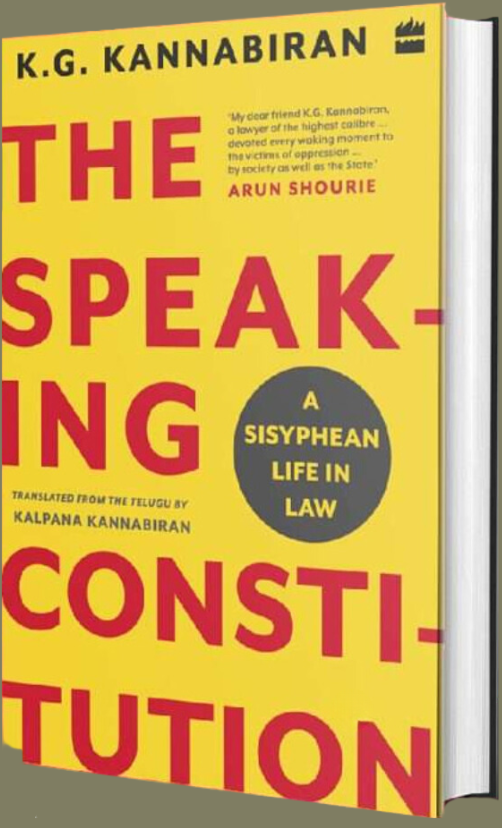In “The Speaking Constitution: A Sisyphean Life in Law,” K.G. Kannabiran traces his life’s work as an incessant struggle for the protection and promotion of constitutional values, unifying the two.
In the age that we live in, countless books are churned out in the mainstream and there is always a degree of saturation of content across fields. Law is no exception. However, of these many, a few arrive at the scene with such a breath of fresh air, instantly making them a canonical text in their own right.
The memoir of Adv. KG Kannabiran, now translated into English as “The Speaking Constitution,” is one such text. To begin with, the very nature of the text makes it a joint venture, as the original Telugu memoir, titled “24 Gantalu: Atmakadhatmaka Samajika Chitram” (24 hours: A Personalised Social History) is one of the few prominent books about Law that is not in English. The growth and development of pedagogy in the vernacular, and the availability of justice to every citizen in a language that they feel comfortable with are still dreams that are far from being realized. The translation and editing work done by KG Kannabiran’s daughter Kalpana Kannabiran, an eminent scholar in her own right, has brought the book national and even international acclaim.
However, Kalpana Kannabiran did not merely translate the book into English. As the editor, she has paid meticulous attention to reinvigorating her father’s thoughts. Revising chapters, providing references, annotations, and relevant citations, as well as writing a preface that serves as an enlightening read in its own right, have all transformed the memoir of a Social Justice Advocate into an authoritative text on the history of civil liberties movement in post-independence India. In her introduction, Kalpana invokes the idea of dialogue as propounded by Bakhtin, and the book becomes a wonderful example of the same.
That seemed to have been the intent of KG Kannabiran from the beginning. For a memoir, the amount of personal knowledge dispelled is strikingly lacking. That has been done deliberately, as he explores and revisits several facets of his life by recalling the cases in which he was involved. This dissolution of the idea of self was a trait that defined Kannabiran and his life’s work.
Kannabiran worked tirelessly for the protection of constitutional values and civil liberties across the country, and the book enlists several major ones, as well as his invaluable role elsewhere such as the Tarkunde Committee and the Bhargava Committee. By commenting and reflecting upon the arguments and judgments over the years, he develops his idea of a Constitutionality he worked for all his life. He says in the book, “A formal compliance with the law, a routine engagement with justice, will not keep justice alive. The Constitution says that Justice–political, social, and economic–should inform all the institutions of the state. Our campaign for a secular democracy should commence from this statement in the Preamble.”
The journey of Kannabiran’s life begins like any first-generation lawyer. He didn’t come from an economically privileged background, and his initial years in practice were filled with hardships. Nevertheless, he fondly recalls those times when the people who helped him become what he later did, and the values of the Constitution that he imbibed in himself at the time. Even later in his life, he says, “I am a lawyer, and I work among people. I have been occupying the same seat in the same room in my office since 1985. Everyone knows where they can find me. In that situation, when there is a crisis, anyone can walk in for my help.”
The ethics of the legal profession do not become for Kannabiran an argument to pull others down; rather, it is the application of the fundamental principles of the Constitution into everyday life. The principles on which Constitutional justice is based are the directives of his life’s work, not just a set of arguments to advance a case. While reflecting upon a case, he states, “It was in the course of this inquiry that I realized why prosecutions fail. Inspectors and prosecutors always think about how a statement can be made to sound rational and foolproof. They prepare a strategic plan and get the witnesses to present their plan. But witnesses, or anyone for that matter, can only state what they see. If they have not witnessed an incident, they will not be able to say anything about it. It matters little how famous the lawyer is. What happens is this. This is also the reason why prosecution witnesses often contradict their statements or turn hostile.”
In regards to the client-lawyer relationship, he divulges a gem for any person entering the legal profession. “…the relationship between the pleader and his client is an amoral one. The first lesson a pleader learns is not to judge the cases a client brings, to be impartial and neutral”. Therefore the question of principles is not relevant in accepting a case. A lawyer is not expected to think about the fairness or unfairness (justice/injustice) of the case he is taking up. In other words, a lawyer must view the world around him in dual terms: one world is that of his client and the case; the second is his personal life. In his relationships with his family, other lawyers, and friends, he has a certain perspective of the world of his choosing. As a lawyer rises in eminence, his world keeps shrinking, and his clients’ worlds keep expanding. In a world of free competition, the lawyer descends into cut-throat competition. In the early days, lawyers, with their expertise, their erudition, and their learning, would win arguments over the opposing party. There were many exemplary lawyers during that time. This was a source of self-fulfillment for them. It was not focused on maximizing earnings as it is today. Yet, neither then nor now are there ladders that make it possible for lawyers to climb up in the profession.”
A problem often encountered with Advocates, even many of the senior members of the fraternity, is the hyperfocus on Law, rendering them lacking in other areas of life. One finds a refreshing exception to this in the book, which is filled with cultural references, ranging from the works of Camus, Oscar Wilde’s “De Profundis,” Akira Kurosawa’s movies, to excerpts from Telugu poetry. Kannabiran presents in himself an example of why an Advocate ought to be culturally and socially well-cultivated, and must make active efforts towards the same.
In his conduct as well, Kannabiran exemplifies the ethicality of the profession. He says, “… if you utter the truth, no matter how many times and before how many people you repeat it, and no matter how many times you are cross-examined, your statement will remain the same. It is only when you lie that your account changes from one recounting to another. This was not a practice generally followed by lawyers. They tended to tutor witnesses, leading to their faltering during cross-examination.”
We see several instances where he disagrees with the judge, and he doesn’t try to shy away from making the fact known to the judge, but always does so in a respectful manner, showing the reverence he has for the legal system. He was a firm believer in the principle of due process, which was reflected in his life’s work. Regarding the manner of interpretation of statutes, he keeps the goal of greater social justice at the forefront, saying, “How is it possible to arrive at such different conclusions based on the same evidence? However, there is an intelligible interpretation for each judgment. A key principle of jurisprudence is that if there are two ways of interpreting an issue, the interpretation that must be adopted is the one that gives the benefit of the doubt to the accused. This is a very good principle. However, the problem is that courts do not deploy this principle in all cases. It is only when the accused are powerful, rich, and influential that they remember this principle. When the accused are poor people or people who oppose the state, our courts never remember this principle. In those cases, they only consider interpretations that are stacked against the accused.”
Kannabiran never regarded any case as too small or too big for his attention, nor did he claim to know all the answers, and leaves questions open throughout the book. He knew his battle wasn’t easy. But just as Camus declares Sisyphus to be happy, the Sisyphean life in Law is as rewarding as it is filled with hardships. On this note, Kannabiran says, “The major articulate premise in the Indian Constitution is ‘Justice’ in the Preamble. Justice as per the constitutional value system is a moderating force of all human relationships as also of all institutions under the Constitution in their relationship with the people.”
By Vishwas Tanwar, 5th Year B.A. LL.B (Hons.), Faculty of Law, The Maharaja Sayajirao University of Baroda, Vadodara

